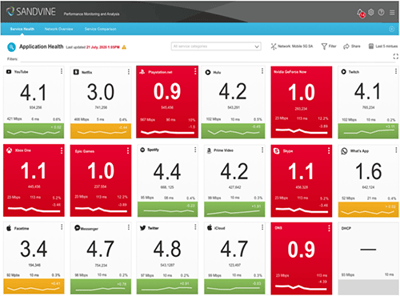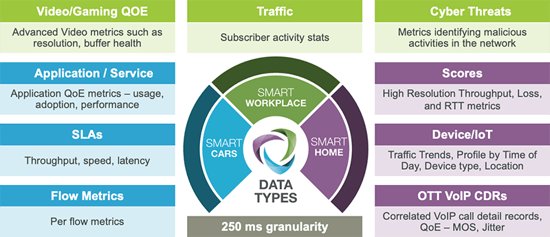Getting the most out of 5G use cases requires a combination of accurate data, real-time analytics and robust policy enforcement
More than 18 months of COVID-driven transformations have led you to rethink what’s possible beyond present-day networks, databases and systems. As you make investments in 5G, cloud, machine-learning, and multi-access edge computing (MEC), you realize network complexity is increasing and can profoundly impact customers’ application experiences across your networks.
Efforts must be made now to tame the inherent complexity, and perhaps even capitalize on it, for example, by ultimately offering 5G network slices—each with its own cloud-based applications and SLAs for latency, speed, and prioritization. While the benefits of network slicing and 5G use cases can be compelling, there can also be potentially serious consequences if there is suboptimal performance of more critical applications, such as autonomous cars, real-time remote patient care, smart cities, and smart manufacturing.  Best-effort approaches and over-dimensioning of pipes will no longer cut it for performance- and latency-sensitive applications. Additionally, the packet gateway data that was essential in 4G evolved packet core (EPC) networks will only offer 70% or 80% visibility, which will be inadequate for managing 5G network slices and services.
Best-effort approaches and over-dimensioning of pipes will no longer cut it for performance- and latency-sensitive applications. Additionally, the packet gateway data that was essential in 4G evolved packet core (EPC) networks will only offer 70% or 80% visibility, which will be inadequate for managing 5G network slices and services.
In order to make 5G networks highly responsive and adaptive to actual in-app quality of experience (QoE), you’ll need true application and network “intelligence," which is the granular insight that goes beyond “video is not performing well” to showing which individual applications are struggling and why.
To get to that point, you need good quality data and a combination of robust analytics, visualization tools, and policy enforcement.
Good quality data
The explosion of downloaded and streaming video, and the continued shift to at-home work means data maturity has to become a top-level priority from leadership all the way down through an organization. Executive buy-in for data governance and sophisticated data management will help free data that sometimes gets trapped in Big-Data siloes. Big Data should no longer be the domain of just a few people on an IT team, but rather be its own entity residing somewhere between the Networking and IT domains (in support of network planning, engineering, operations and technology, and all important business initiatives).
Data will also come from an increasing number of sources and possess a greater variety of properties— structured, unstructured, semi structured, as well as encrypted, unencrypted, symmetrical or asymmetrical.
To help you mitigate some of the complexity, we are providing a single data set that is consistent and scalable so that you can readily integrate it into your Network/Service Operations Centers, Customer Experience Management systems and Big Data Lakes.
 That data can be processed in near-real-time at the core, edge, or cloud, as we can extract metrics from each application data flow every 250 millisecond. In fact, we have been recognized for the sophisticated visualization tools we provide to tease out contextual insight about network performance and QoE. Our benchmarking dashboards “score” user experiences with customizable drill-downs into KPIs categorized by app, user, device, network, location, and demographics.
That data can be processed in near-real-time at the core, edge, or cloud, as we can extract metrics from each application data flow every 250 millisecond. In fact, we have been recognized for the sophisticated visualization tools we provide to tease out contextual insight about network performance and QoE. Our benchmarking dashboards “score” user experiences with customizable drill-downs into KPIs categorized by app, user, device, network, location, and demographics.
We help our customers classify more than 95% of traffic using an expansive database of 5000+ application signatures and machine learning-based analytics that dissect data and identify patterns, trends and anomalies. This information is then presented in an easily digestible form for people across the organization as prepackaged, persona-driven 5G use cases for CTOs, Planning and Engineering, Operations, Big Data, and Marketing departments:
- Chief Technology Officer (CTO): performance and operational monitoring, real-time subscriber insights, 5G adoption analysis
- Planning and Engineering: capacity planning, slice load analysis, NF load analysis, 5G adoption analysis
- Operations: real-time subscriber insights, video QoE, slice load analysis
- Big Data: User behavior and demographics, subscriber insights, video QoE, Cyber threat analysis
- Marketing: Zero-rating and application-based plans, usage-based services, service and subscriber analysis
Making data ‘actionable’
The tailored use cases empower users to intelligently react to changes they observe, be they application degradation, customer usage, traffic volumes, or network utilization. Because the combination of quality data and predictive analytics is complemented by our real-time policy control (PCEF), the insight observed becomes “actionable,” with policy consistently enforcing procedures, processes, and “actions” for different scenarios. This also leads to greater control over services, with higher degrees of personalization by application, device, location, QoS, and other parameters.
As personalization and control evolves, you can drive more sophisticated monetization of applications, applying policies around application and usage-based plans, zero-rating, analytics services, security services, and mobile and IoT device management services.
We feel our efforts to combine real-time, quality data with analytics, visualization, and policy will set the stage for many benefits, including: just-in-time capacity management and operational efficiencies, improved margins, enhanced service quality, and better QoE.
QoE is what matters most to customers, as they care little about the technological magic behind the applications they value most. When it comes to streaming and on-demand video services, gaming, enterprise communications and collaboration, social networking, and interactive messaging, people just want to know they got the best experience and productivity gains possible—regardless of their locations, circumstances or devices.
That level of service will be increasingly difficult to assure as you evolve to support hundreds-of-thousands if not millions of mobile devices and collocated users — each with its own demands and policies for quality-of-service (QoS), connectivity, availability, mobility, and performance. As applications become more dependent on network performance and the way you analyze, optimize and monetize network slices, we are committed to helping you measure and assure QoE across the apps at the heart of your 5G and IoT services.
To learn more about our cloud-enabled, data-first approach to improving application QoE, and improving network performance, check out our Mobile Internet Phenomenon Report and feel free to contact us to learn more about our Application and Network Intelligence Portfolio, 5G Service Intelligence Engine, and Analytics.
Topics: Featured Blog Header, Quality of Experience (QoE), Application and Network Intelligence





